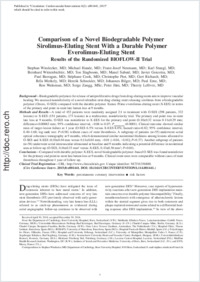Comparison of a novel biodegradable polymer sirolimus-eluting stent With a durable polymer everolimus-eluting stent results of the randomized BIOFLOW-II trial
- Windecker, Stephan Department of Cardiology, Bern University Hospital, Bern, Switzerland
- Haude, Michael Städtische Kliniken Neuss, Lukaskrankenhaus GmbH, Neuss, Germany
- Neumann, Franz-Josef Universitäts-Herzzentrum Freiburg–Bad Krozingen, Bad Krozingen, Germany
- Stangl, karl Charité-Campus Mitte, Berlin, Germany
- Witzenbichler, Bernhard Charité Campus Benjamin Franklin, Berlin, Germany
- Slagboom, Ton Onze Lieve Vrouwe Gasthuis, Amsterdam, The Netherlands
- Sabaté, Manel Hospital Clínic, Thorax Institute, Barcelona, Spain - IDIBAPS, University of Barcelona, Barcelona, Spain
- Goicolea, Javier Hospital Puerta de Hierro, Madrid, Spain
- Barragan, Paul Polyclinique les Fleurs, Ollioules, France
- Cook, Stéphane Hospital and University of Fribourg, Switzerland
- Piot, Christophe University of Montpellier, Montpellier, France
- Richardt, Gert Segeberger Kliniken, Bad Segeberg, Germany
- Merkely, Béla Semmelweis University Heart and Vascular Center, Budapest, Hungary
- Schneider, Henrik Universitätsklinikum Rostock, Rostock, Germany
- Bilger, Johannes Klinikum Nürnberg Süd, Nürnberg, Germany
- Erne, Paul Lucerne Canton Hospital, Lucerne, Switzerland
- Waksman, Ron MedStar Health Research Institute, Washington, DC
- Zaugg, Serge Institute of Social and Preventive Medicine, University of Bern, Bern, Switzerland
- Jüni, Peter Institute of Social and Preventive Medicine, University of Bern, Bern, Switzerland
- Lefèvre, Thierry ICPS, Massy, France
-
02.01.2015
Published in:
- Circulation: Cardiovascular Interventions. - 2015, vol. 8, no. 2, p. e001441
English
Background—Biodegradable polymers for release of antiproliferative drugs from drug-eluting stents aim to improve vascular healing. We assessed noninferiority of a novel ultrathin strut drug-eluting stent releasing sirolimus from a biodegradable polymer (Orsiro, O-SES) compared with the durable polymer Xience Prime everolimus-eluting stent (X-EES) in terms of the primary end point in-stent late lumen loss at 9 months.Methods and Results—A total of 452 patients were randomly assigned 2:1 to treatment with O-SES (298 patients, 332 lesions) or X-EES (154 patients, 173 lesions) in a multicenter, noninferiority trial. The primary end point was in-stent late loss at 9 months. O-SES was noninferior to X-EES for the primary end point (0.10±0.32 versus 0.11±0.29 mm; difference=0.00063 mm; 95% confidence interval, −0.06 to 0.07; Pnoninferiority<0.0001). Clinical outcome showed similar rates of target-lesion failure at 1 year (O-SES 6.5% versus X-EES 8.0%; hazard ratio=0.82; 95% confidence interval, 0.40–1.68; log-rank test: P=0.58) without cases of stent thrombosis. A subgroup of patients (n=55) underwent serial optical coherence tomography at 9 months, which demonstrated similar neointimal thickness among lesions allocated to O-SES and X-EES (0.10±0.04 mm versus 0.11±0.04 mm; −0.01 [−0.04, −0.01]; P=0.37). Another subgroup of patients (n=56) underwent serial intravascular ultrasound at baseline and 9 months indicating a potential difference in neointimal area at follow-up (O-SES, 0.16±0.33 mm² versus X-EES, 0.43±0.56 mm²; P=0.04).Conclusions—Compared with durable polymer X-EES, novel biodegradable polymer–based O-SES was found noninferior for the primary end point in-stent late lumen loss at 9 months. Clinical event rates were comparable without cases of stent thrombosis throughout 1 year of follow-up.Clinical Trial Registration—URL: http://www.clinicaltrials.gov. Unique identifier: NCT01356888.
- Faculty
- Faculté des sciences et de médecine
- Department
- Médecine 3ème année
- Language
-
- English
- Classification
- Pathology, clinical medicine
- License
- License undefined
- Identifiers
-
- RERO DOC 255876
- DOI 10.1161/CIRCINTERVENTIONS.114.001441
- Persistent URL
- https://folia.unifr.ch/unifr/documents/304427
Statistics
Document views: 76
File downloads:
- coo_cnb.pdf: 206
